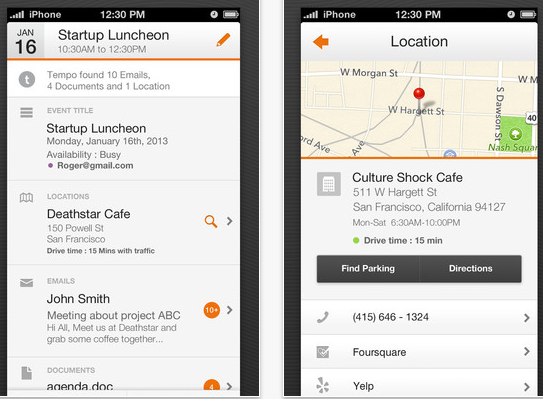Tempo “Calendar Assistant” Uses Search Like Google Now
Smart calendar app Tempo announced a $10 million “series A” funding round this morning. The app aims to replace the native calendar apps on smartphones. Needless to say, that’s a tall order. However, the technology behind the app is derived from the same US Defense Department (DARPA) SRI-led research that produced Apple’s Siri and Yahoo’s Summly, […]

Needless to say, that’s a tall order. However, the technology behind the app is derived from the same US Defense Department (DARPA) SRI-led research that produced Apple’s Siri and Yahoo’s Summly, among a few other “assistant” apps and services.
As part of the Tempo investment round, Norman Winarsky, VP of SRI Ventures, has joined Tempo’s Board of Directors
The original DARPA project was called CALO, which stands for Cognitive Assistant that Learns and Organizes. The project began in roughly 2003 and concluded in roughly 2008. SRI has been using the technology to launch companies and apps since that time. Siri is the best known among them.
Tempo doesn’t rely on exactly the same technology as Siri; its core capabilities are drawn from a different aspect of the CALO project. Tempo integrates with smartphone user’s contacts, existing calendar, email and social networks to create a more “actionable” user experience than a conventional calendar.
The Tempo press materials capture the philosophy and vision behind the app:
The calendar is life’s uber-dashboard to the “who, what, where, when and why” of the actions in one’s day. Tempo Smart Calendar connects the dots by presenting all the information people need and then behaves like an assistant by making this information easily actionable right from the calendar. It was designed to be both beautiful and smart, saving time and eliminating hassles.
Tempo delivers a range of features that go beyond typical native calendar apps. Among the things that Tempo does is offer maps and directions, provide LinkedIn background information on meeting attendees, connect related documents and emails to meeting entries, offer birthday reminders and flight status updates.
Tempo CEO Raj Singh told me that rather than simply trying to create another marginally better third party calendar app, he sees the calendar as a kind of “proxy for an assistant.” In other words, the calendar is a UI or doorway into a range of “assistant” functions. Singh said Tempo is actually delivering a number of “Google Now-esque experiences.”
Tempo builds a “semantic graph” of users’ data. It performs “semantic analysis” of that data to figure out how things are related and to add actionable functionality to the calendar. It’s a “push assistant” in much the same way Google Now is. By contrast Siri is a “pull assistant” requiring explicit user queries or requests.
As part of the process of connecting all the data dots, Singh explained that Tempo is running “semantic search in the background.” This is somewhat ironic given the absence of a conventional search function in the app.
Tempo started as smartphone app, but a tablet app will follow and later a desktop experience. “Ultimately we’ll bring a calendar experience to all your screens,” says Singh.
I asked Singh about Tempo’s revenue outlook. He said there will probably be affiliate revenue. But he emphasized that there was an enterprise strategy Tempo is working on with a larger revenue opportunity. He said that conventional mobile advertising would disrupt the Tempo experience and was therefore unlikely.
Singh further explained that 20 percent of Tempo’s users now use it as their primary calendar (four or five times a day). He added that the company’s “conversion rates” (adoption as a native calendar substitute) are also very high. However the app still lacks certain capabilities and functionality — like a search box.
Singh responded by saying that there’s an ambitious feature roadmap ahead.
Opinions expressed in this article are those of the guest author and not necessarily Search Engine Land. Staff authors are listed here.
Related stories
New on Search Engine Land

